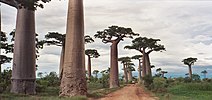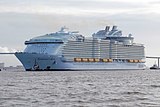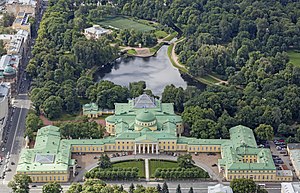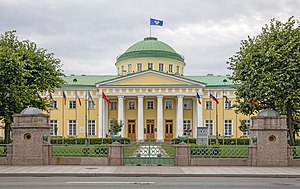From today's featured articleThe flora of Madagascar consists of more than 12,000 species of vascular and non-vascular plants. Around 83 per cent of Madagascar's vascular plants are found only on the island. These include five entirely endemic plant families as well as most of the over 900 orchid species, the traveller's tree, the Madagascar periwinkle, six species of baobab (pictured) and around 200 species of palms. The high degree of endemism is due to Madagascar's long isolation following its separation from the African and Indian landmasses in the Mesozoic Era. Today, humid forests, including the lowland forests, are found on the eastern plateau. Much of the central highlands is grassland. In the west are dry forest and succulent woodland. Unique spiny thickets are in the southwest, and mangroves occur on the west coast. While 10 per cent of the land surface is protected, much of the native flora is threatened, especially through dramatic deforestation. (Full article...)
Recently featured:
Did you know ... Elastomeric respirator in cybergoth fashion
|
In the news
On this daySeptember 7: Labor Day in the United States (2020)
More anniversaries:
|
From today's featured list
As of June 2020, the largest cruise ship, Symphony of the Seas (pictured), has a gross tonnage (GT) of 228,081, is 361 metres (1,184 ft) long, 65.7 metres (216 ft) wide, and holds up to 6,680 passengers. Cruise ships can carry thousands of passengers in a single trip, and are some of the largest ships in the world by GT, bigger than many cargo ships. Cruise ships started to exceed ocean liners in size and capacity in the mid-1990s; before then, few were more than 50,000 GT. In the decades since, the size of the largest vessels has more than doubled. There have been nine or more new cruise ships added every year since 2001, most of which are 100,000 GT or greater. In the two decades between 1988 and 2009, the largest cruise ships grew a third longer (268 to 360 m [879 to 1,181 ft]), almost doubled their widths (32.2 to 60.5 m [106 to 198 ft]), doubled the total passengers (2,744 to 5,400), and tripled in volume (73,000 GT to 225,000 GT). (Full list...)
Today's featured picture
|
The Tauride Palace is one of the largest and most historic palaces in Saint Petersburg, Russia. It was designed by Ivan Starov for Prince Grigory Potemkin, and was constructed between 1783 and 1789. After the owner's death, it was purchased by Catherine the Great, who constructed a theatre in the east wing and a church in the west wing. Many improvements were also made to the grounds, including construction of the Admiralty Pavilion, the gardener house, the orangery, glass-houses, bridges, and ironwork fences. Although the exterior of the building was rather plain, the interior was very luxurious. More recently, the building housed the first Imperial State Duma (1906–1917) and the post-revolution provisional government. Photograph credit: Andrew Shiva
Recently featured:
|
Other areas of Wikipedia
- Community portal – Bulletin board, projects, resources and activities covering a wide range of Wikipedia areas.
- Help desk – Ask questions about using Wikipedia.
- Local embassy – For Wikipedia-related communication in languages other than English.
- Reference desk – Serving as virtual librarians, Wikipedia volunteers tackle your questions on a wide range of subjects.
- Site news – Announcements, updates, articles and press releases on Wikipedia and the Wikimedia Foundation.
- Village pump – For discussions about Wikipedia itself, including areas for technical issues and policies.
Wikipedia's sister projects
Wikipedia is hosted by the Wikimedia Foundation, a non-profit organization that also hosts a range of other projects:
Free media repository
Wiki software development
Wikimedia project coordination
Free textbooks and manuals
Free knowledge base
Free-content news
Collection of quotations
Free-content library
Directory of species
Free learning resources
Free travel guide
Dictionary and thesaurus





